 UK Royal Navy (1916-1945)
UK Royal Navy (1916-1945)1916 program: HMS Scott, Bruce, Douglas, Campbell, MackKay, Malcolm, Montrose, Stuart (Built 1916-1920).
WW1 British Destroyers:
26 knotters | 27 knotters | 30 knotters | 33 knotters | Turbine destroyers | River class | Cricket class | Tribal class | Beagle class | Acorn class | Acheron class | Acasta class | L class | M class | Repeat M class | Medea class | Faulknor class FL | Marksman class FL | Parker class FL | Talisman class | Shakespeare class FL | R class | S class | Repeat R class | V class FL | Scott class FL | V class | W classSecond part on the late British WWI flotilla Leaders. The Admiralty type (Scott class) were the second flotilla leaders built almost alongside the Shakespare class or “Thornycroft type” proposed by the latter company. They were the fastest and best armed destroyers of their age and really defined their evolution in the interwar. Not only the “A” and “B” standard destroyers from 1928-31 were based on this design, but in the meantime, concerned yards produced these types for many navies across the world. Very close to the Thornycroft design but under Admiralty specs, 8 of these larger ships were built at Camell Laird (2 cancelled) and two at Hathorne Leslie. Some missed WWI (Scott was torpedoed in 1918) and apart Bruce sunk as target in November 1939 after heavy damage and HMAS Stuart, resold to Australia in 1933, they all took part as escorts in WW2. Collectively with the Thornycroft type they were also called the “Scots”, named after Scottish war leaders.
This is the second post on British interwar Destroyer lineage leading to WW2 and early cold war “classic destroyers” such as the Battle and Daring.
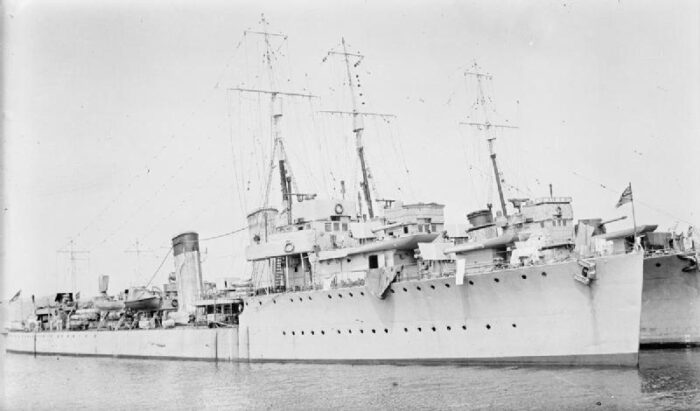
Development of the Admiralty class Flotilla Leaders
The Scott class or “Admiralty Type” were Flotilla leaders of a new kind was developed already in 1913 following a planned replacement for the ill-fated HMS Swift. By October 1913, the admiralty worked on a new design, looking at improving the old Tribal class, as a base for a proper flotilla leader with long range communication and extra staff facilities: Crusader, Maori or Zulu were tested with the Poulsen long-range wireless communication suite and a larger bridge plus extra accommodations for the Captain (D)s staff. Previous classes had been the Lightfoote class (launched 1915) from Cammell Laird and the Faulknor class by JS White as an alternative. Then Camell Laird’s improved “Parker class” was followed by the Admiralty V Type, launched 1917. But the fear of larger German destroyers being completed, notably using 15 cm guns, prompted an upgrade. Thornycroft proposed to the admiralty through the War Emergency Programme of April 1916 a larger design, accepted and soon called the “Thonycroft type” (Shakespeare class).
In the spring of 1916 the admiralty bounced on Thornycroft’s answer to the Directorate of Naval Construction)’s leader design below 1,800t, 33-34 knots with 4.4in guns and anti-airship pom-poms. Accomodations were to be even larger and better suite for the Captain (D), extra Lieutenant, WO signaller and 8 extra staff. It was proposed initially to retake the M class macxhinery but the design evolved until approved in December 1913 as the Lightfoot and Marksman with tenders in April 1914 for Kempenfelt and Nimrod with names reflecting the letter of the class they would lead. The first four leaders were successful enough that on November 1914 three more were ordered, named after Milton’s Paradise Lost.
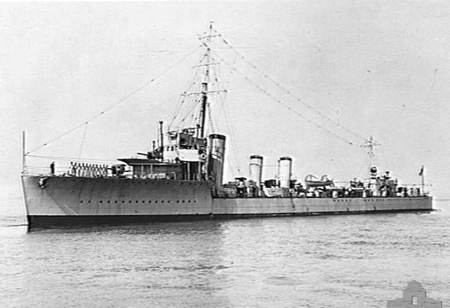
HMAS Anzac, Parker class flotilla leaders
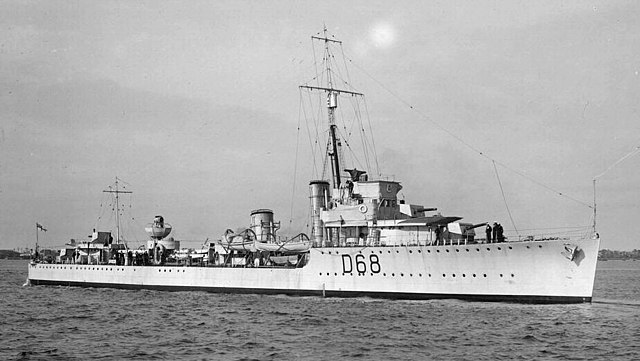
HMAS Vampire, “V” class or Admiralty V Type flotilla leaders, capable of 34 kts, designed in April 1916 as repeat Parkers built at Cammell Laid and way cheaper.
However the admiralty needed thee leaders to such a point it decided to use also Arethusa class light cruisers as flotilla leaders in the Grand Fleet, whereas it forcibly requisitioned four of the six Chilean ordered Parker class (from J S White in Cowes) with an altered distribution of armament, twin Torpedo tubes and single 4-in guns on the forecastle and quarterdeck as well as 2pdr Mk I pom-poms. Survivors were refitted and sold back to Chile in May 1920.

V116 design, one of the 1500t German destroyers feared by the admiralty. They had four 6 inches (152 mm) guns and four 600 mm torpedo tubes for 2,415 tonnes. But only S-113 was conducting its trials the last days of the war, and became Amiral Senes in French service, while V-116 became Premuda in Italian service. Rumors were true, and they were only German flotilla leaders even built. The rest were scrapped on slip postwar.
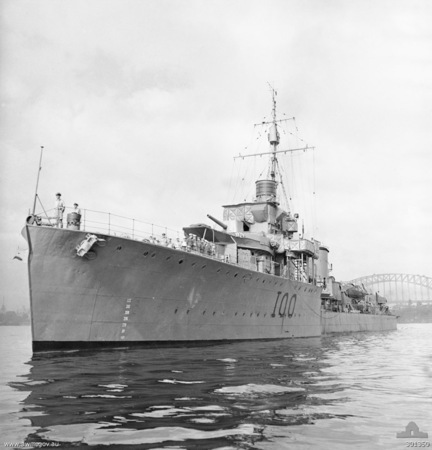
Thornycroft flotilla leader arrived well a propos since DNC was instructed by the Admiralty to work out much larger designs capable of dealing with the rumoured new German destroyers. Instad of 4.4 in guns a compromise was offered in which they would adopt instead army 4.7in field guns, and four of them superimposed forward and aft, plus a fifth on a bandstand between funnels. In addition they and triple 21-in TT and were extremely powerful and fast at 38 knots on trials, making them the most heavily armed destroyers in the world, making a great impression.
In the spring of 1916 the admiralty, which approved plans for the Thornycroft Type ordered to Cammel Laird, until then the designated Flotilla leader constructor, to come out with a modified design. It was based on the Thornycroft type but adapted to Admiralty standards in order to be tendered to other yards and mass produced.
This design of flotilla leader prepared in the spring of 1916 was to incorporate features of the Shakespeare class, but using standard Admiralty practice so that contracts could be given to other builders. It was suggested that Thornycroft’s drawings should be given to Cammell Laird to enable them to achieve similar weight-reductions and Barrington and Hughes were in fact ordered to the Shakespeare design, but the DNC advised against this move as non-specialist builders were unlikely to be able to achieve similar standards, and the two were subsequently changed to standard Admiralty leaders. The design was very similar to the Shakespeare, but they were heavier and slower. On her acceptance trials Scott reached about 33kts at a displacement of 1716t, and in a comparative trial reached 36.63kts at 1770t. Machinery weighed about 70t more than in the Thornycroft boats. Externally the major difference was the funnels, which were round in the Admiralty design, instead of flat-sided. Scott was ordered in April 1916, followed by Bruce and Douglas in December, and the remainder in April 1917.
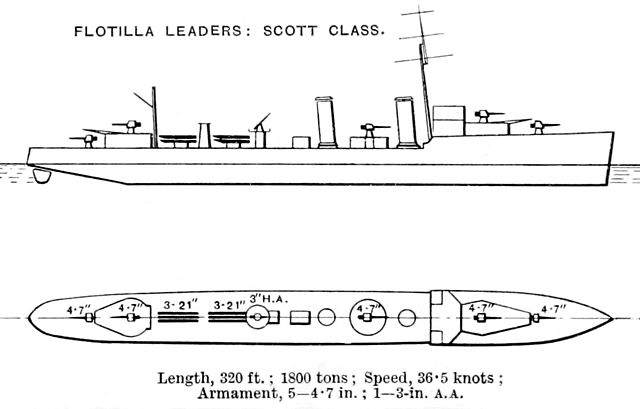
All except Mackay and Malcolm were completed in time to take part in the great war unlike the Thornycroft types (only two on five). The two final orders, Barrington and Hughes were cancelled just as the last two of the Thornycroft orders, and originally ordered directly to the Thornycroft leader design. Stuart was transferred to Australia in 1933 and the remaining ones, except HMS Bruce served for the duration of World War II, as converted escort ships. These made these ships one of the rare destroyers to see both world wars, something which was an oddity at the time. Indeed destroyer’s light construciton and powerful machinery made them generally more worn out than other types likes cruisers and battleships, and maintenbance investments were low prioritity for them. This also tells volums about the strenght of this design and construction quality in general. They were all retubed also at some point in the interwar.
Design of the class

Thornycroft design. The Scott or admiralty type was virtually a repeat of the latter.
Hull and general design
The admiralty design was prtty much a repeat of the previous Thornycorft design, modified the same was to be used as command ship with aflag staff with additional crew, offices and signalling equipment. They were very close in design to the Thornycroft type leaders with the expeption of their their two narrow funnels of equal height, whereas the Thornycroft designs had instead broad and slab-sided funnels. The silhouette was the same, with a forecastle 2/3 of the their lenght, superfiring guns fore and aft, two funnels and two masts, all raked, amdidship “Q” gun between them, duperfiring pair aft, and a pair of triple torpedo tubes banks with a searchlight platform in between. This was a well balanced design and like the previouss Shakespeare class, they inspired destroyer construction in the interwar.
In dimensions they were shorter than the Thonycrofts, but heavier at 1,580 tons standard and 2,053 tons full load (although sources diverged between them). They measured 322 ft 6 in overall or 98.30 m long, and in beam 31 ft 9 in of 9.68 m (so wider than the Thonycrofts) and in draught 12 ft 6 in (3.81 m), which was the same. The rudder, propellers and drive shafts were unchanged. The general hul lines were the same, with a constant beam for less than 50% at deck level, very fine lines forward and some flare, a near straight bow, and well rounded straight poop. The brigde superstructure was well developed with an enclose navugation bridge and the flotilla captain open bridge above plus all signalling and wireless communication equipment.
Barrington and Hugues were ordered also from Cammell Laird but cancelled by December 1918.
Powerplant
There too, this was a repeat of the Thornycoft design, albeit with two Parsons single reduction turbines coupled with four yarrow boilers, for a total of 40,000 shp (30,000 kW). Montrose and Stuart, both ordered to the adapted Thonycroft design and diverged by having Brown-Curtis steam turbines instead and being rated at 43,000 shp (32,000 kW), for an extra ½ knot. They were still fast on paper at 36.5 knots (67.6 km/h) but it was for the Montrose sub-class, trials speed probably below36 knots in ideal conditions. As for range, they were similar in performances at 5,000 nmi (9,260 km) for 15 knots (28 km/h). Good for WWI standard this was unsufficient for WW2 and so they were modified to carry more fuel oil but unlike the Thonrycroft did not loose a boiler in the process. In general they were slower. On acceptance trials, Scott only made 33kts for 1,716t. After modification she was capable of reaching 36.63kts at 1,770t but her machinery weighed about 70t more than in the Thornycroft boats.
Armament
The Scott class repeated the Thornycroft design completely, to the exception of their AA gun located aft of the second funnel on a bandstand. Since in 1918 the greatest threat was not from aircraft but slow moving, high altitude airships, they all received the same QF 3-inch (76 mm) 20 cwt anti-aircraft gun instead of a 12 pdr HA Mark VIII AA. Needless to say this was modified heavily before and during WW2.
BL 4.7 in/45 Mark I
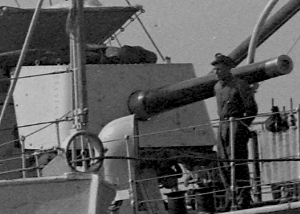 Five of them installed on superfiring positions fore and aft and an extra one planted on a raised platform between the two funnels, usable for broadsides. Developed in 1918 for the Mark I and adopted for the new class, they were built in limited quantities, the Mark II by 1940.
Five of them installed on superfiring positions fore and aft and an extra one planted on a raised platform between the two funnels, usable for broadsides. Developed in 1918 for the Mark I and adopted for the new class, they were built in limited quantities, the Mark II by 1940.
The Mk I weighted 7,000 pounds (3,200 kg) for a 213 inches (5.4 m) bore (45 calibres) barrel
It fired a 50 pounds (22.7 kg) 4.724 inches (120 mm) shell at 2,670 feet per second (814 m/s)
It used a Welin breech block for 5-6 RPM
Elevation was -9.5° to +30° with 240° traverse, range 15,800 yards (14,450 m) at 30°.
These were all shielded, just enough to cope with light shrapnel (c5 mm).
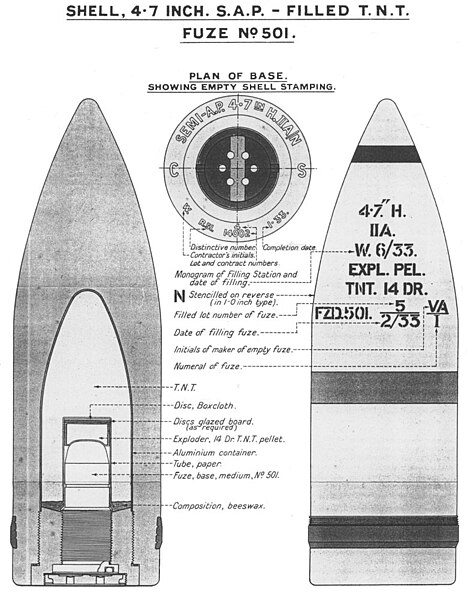
QF 3-inches/45 Mark II 20 cwt
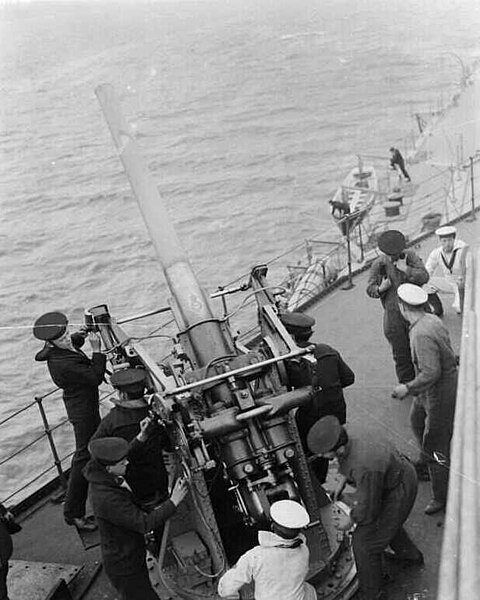
This single gun was installed on a raised bandstand aft of the second funnel, close to the forward torpedo tubes bank.
Mass: 2,240 lb (1,020 kg), gun and breech, Bore 11 ft 4 in (3.45 m), 11 ft 9 in (3.58 m) overall. Crew: 11
They fired a Fixed 16 lb (7.3 kg) QF HE 76.2 × 420 mm R via a Semi-automatic sliding-block betech for 16-18 rpm.
Elevation was up tp 90° with a muzzle velocity of 2,000 ft/s (610 m/s), range 16,000 ft (4,900 m) effective, 22,000 ft max.
21-in torpedo tubes
The two triple banks were located aft of the structure behind the second funnel, with the searchlight platform installed in between. The two banks were assorted with cranes fir reload at sea. Spare torpedoes were likely stored alongside the aft and amidship deck structures. The banks were narrow due to the third tube being mounted over the two others.
They were likely of the 21″ (53.3 cm) Mark IV* typed entering service in 1917.
Weight: 3,206 lbs. (1,454 kg), lenght 22 ft 7.5 in (6.896 m).
Payload 515 lbs. (234 kg) TNT.
Powered by Wet-heater.
Range/Speed settings 8,000 yards (7,300 m)/35 knots, 10,000 yards (9,150 m)/29 knots or 13,500 yards (12,350 m)/25 knots
⚙ specifications Scott 1918 |
|
| Displacement | 1,580 tons standard, 2,053 tons full load |
| Dimensions | 322 ft 6 in x 31 ft 9 in x 12 ft 6 in (98.30 x 9.68 x 3.81 m) |
| Propulsion | 2 shafts, 2 Parsons single reduction turbines, 4× Yarrow-type boilers 40,000 shp (30,000 kW) |
| Speed | 36.5 knots (67.6 km/h) |
| Range | 500 tons oil, 5000 nm (9,260 km) at 15 knots |
| Armament | 5× BL 4.7 in Mark I, 1× QF 3-in 20 cwt, 2×3 21 in TTs |
| Sensors (ww2) | |
| Crew | 164 |
Interwar and Wartime Modifications
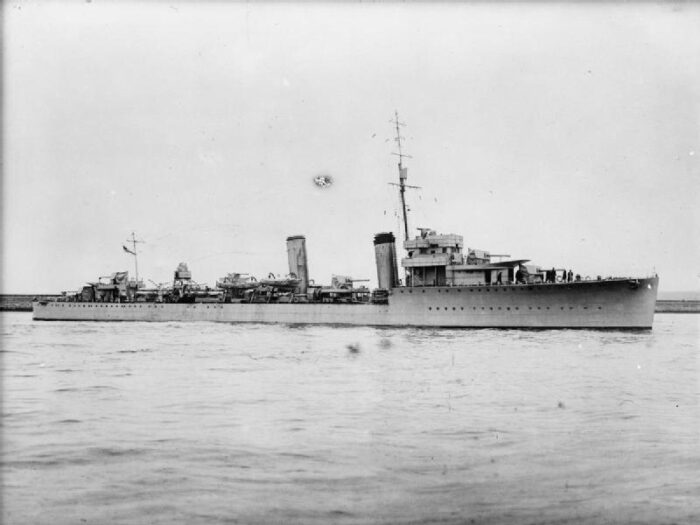
Douglas after conversion to a short range escort
HMS Douglas had limited modifications between wars but in 1939 she got the standard escort conversion auster version, losing her Q or amidships 4.7-inch gun for two 2-pounder (40 mm) “pom-pom”, aft funnel shortened to improve the fire arc of their unchanged 3 inch AA gun. Later in 1942 she received three Oerlikon 20 mm AA then two Oerlikons later replacing the 2-pounders. She also was fitted with a Radar Type 286, and later the Type 290 and Type 271 as well as HF/DF (“Huff Duff”) radio direction-finding gear to located U-Boats surfaced communicating at long distance and working by trigonometry. When converted fully as short-range escort she lost two more 4.7 inch guns, “A” and “Z” as a torpedo tubes bank. Forward on deck was located the Hedgehog anti-submarine mortar, and eight depth charges throwers installed at the rear with a complement of 70 charges.

HMS Campbell
HMS Campbell: at the start of the Second World War saw her amidships 4.7-inch gun replaced by two 2-pounder pom-poms, and aft funnel shortened tas above and bt 1941 she lost her “X”-gun, the superimposed one aft, replaced by her 3-inch AA gun, relocated from her original position. In their place, two Pompoms were installed, and both sets of torpedo tubes were retained. her bridge wings were reinforced to see the installation of two Oerlikon 20 mm cannon and more later replaced all her 2-pounders AA. She had originally a Type 286 radar and later the Type 290 and Type 271 plus HF/DF antenna on her top mast.
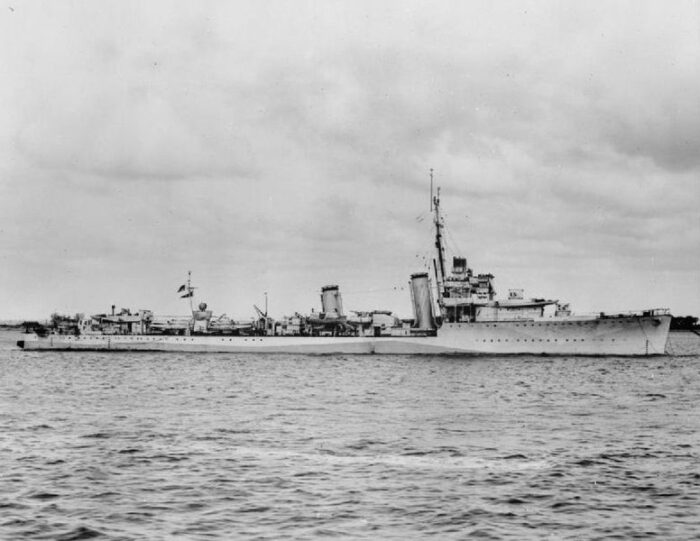
HMS MackKay: HMS Mackay like the others lost her amidships 4.7-inch gun replaced by two 2-pounder (40 mm) “pom-pom” autocannonas and aft funnel shortened. In 1941-1942 her 3-inch AA gun replaced her “X” main gun aft, two 20 mm Oerlikonmounted on the wings, all torpedo tubes retained, and enough throwers for a 10-depth charge pattern. She had from the start a Type 271 radar mounted above the sbridge and replacing the low-angle director and associated rangefinder. The Type 291 radar was mounted at the top of mast. In 1943 she received a twin 6-pounder (57 mm) in stead of her “A” positition 4.7-inch gun to deal with German E-boats.

Author’s profile HMS Monrose Western Approach 1943
HMS Montrose: Like her sisters she lost her amidships 4.7-inch gun, replaced by two 2-pounder (40 mm) “pom-pom” and aft funnel shortened while from 1942, the 3-inch AA was swapped for the main gun “X” position aft replaced by with two 20 mm Oerlikon autocannon plus two on the bridge wings. All torpedo tubes were retained and she was fitted with extra depth charge throwers. She was equipped like MacKay with the same Type 271 radar on the bridge, and Type 291 atop her mainmast. In 1943 she also received a twin 6-pdr in “A” to deal with E-boats.

HMS Monrose with a 6-pdr turret
HMAS Stuart:

In Australian service from 1933 she had an interesting conversion story. In 1941 for her Mediterranean service she lost her Q and Y positons 4.7 in/45 for four single 20mm/65 M1940 (Italian), 2 DCT and 2 DCR and later in 1942 she was completely modified for her pacific service and converted to an APD, amphibious assault destroyer: Two boilers were removed and the space free for accommodations to carry US marines. DShe lost two remaining main guns, her 3-in/45 AA gun and three 20mm/65 AA gins as her four DCT and 3 DCR. Instead she received an extr 40mm/39 2pdr QF Mk VIII, and seven 20mm/70 Oerlikon Mk II/IV AA guns, plus davits to catty and operate LCVPs.
Armament
2pdr QF Mk VIII

The pompom was somewhat ampered by the ineffective Mk III director, later replaced by the MK IV Director with a Gyro Rate Unit and Type 282 radar. Later they were estimated less effective than 40 mm Bofors but kept due to the lesser Luftwaffe actions in the Atlantic and priority being given to larger ships. Typically the Scott class destroyers had a pair of these and a pair of Oerlikons.
40 mm L/39. Shell 2 lb. (980 g)/1.8 lb. (820 g) HV round. 115 rpm fully automatic
Effective Range 3,800 yards (3,475 m) or 5,000 yards (4,572 m) HV, ceiling 13,300 feet (3,960 m)
Muzzle Velocity 2,040 ft/s (622 m/s) or 2400 ft/s (732 m/s) with HV.
Hedgehog
Most received in 1942 instead of their”A” position main gun forward a 24 tubes 178mm Hedgehog ASWRL. There was suspended platform woth location for 24 launcher spigots firing a 65 lb (29 kg) 7 in (178 mm) rocket carrying 30 lb (14 kg) TNT or 35 lb (16 kg) Torpex to 200–259 m (656–850 ft) and explosing by contact. They created a circle like pattern on the suspected contact, leaving little change of survival especially to a just submerged U-Boat. The charges were too small to crack open a hull but at least they could create leaks and oil slicks that could be a position giveaway.
Depht Charges
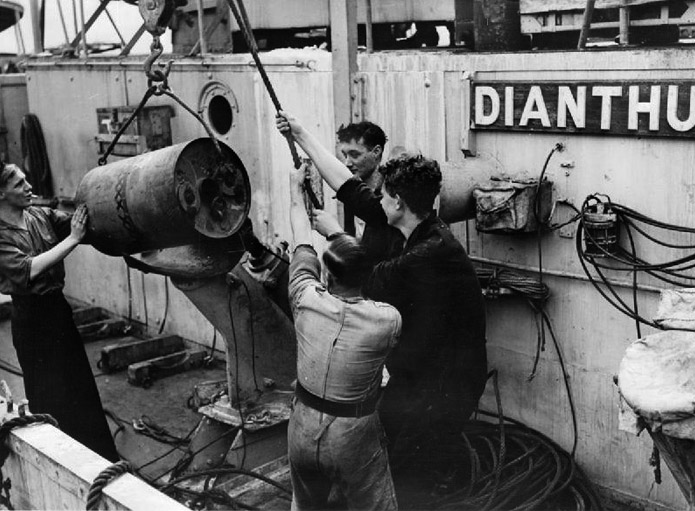
Mark VII depth charge thrower being reloaded.
The usual set comprised from two to four Mark II Depth Charges Throwers (DCT) aft on the poop deck, facing either side, and one to two Depth Charge Racks (DCR) at the stern. Each carried five charges but they were railing to the aft superstructure for a total storage of 40 more DCs. Reload was made by hand, using winches, always a dangerous task with a rolling deck washed by waves. These depht charges were of the standard British type, meaning it was the Mark VII: In entered service in 1939, weighted 420 lbs. (191 kg) and carried a 290 lbs. (132 kg) TNT with a sink Rate or Terminal Velocity of 9.9 fps (3.0 mps) with a max setting at 300 feet (91 m) later 500 feet (182 m).
It’s possible they were later upgraded to the the Mark X (1944) and the Mark X*. The X** was not introduced in service in 1945 despite its great depth (down to 1,500 feet (457 m)). Squid and Hedgehog made them obsolete. There are doubts also if the Mark VII Heavy studied from 1940 and proper to depth charge launchers were used aboard, outside experimentally. Weighting 420 lbs. (191 kg) with a 290 lbs. (130 kg) TNT charge, they had a sink rate/terminal velocity of 16.8 fps (5.1 mps) and a 300 feet (91 m) max setting, helped with a 150 lbs. (68 kg) cast-iron weight attached. The idea was to reach the U-Boat faster, and it was claimed it could split open a 0.875 inch (22 mm) hull at 20 feet (6.1 m), or force to surface at 12 m or more. The game changer was a minol charge (1942) for better results, with a 30% increase.
Sensors
Sonars
Type 124: From 1937, improved Type 121, range 2500 yards, 1st with chemical range recorder.
Type 127: From 1940, mostly installed on British Flower class sloops, first with a bearing plotter.
Type 144: From 1943, range 2500 yards (2300 meters) to 3000 yards (2700 meters), integrated into the fire control and coupled with Hedgehog. 1st with bearing recorder, automatic scanning, turning 5 degrees after each ping, often coupled with the Type 147 “Sword” depth finding sonar with a beam steerable vertically. Also coupled with the Q attachment reducing the under hull blind spot. 60° deep vertical beam, trained with the main Type 144 transducer.
Radars
Type 286/286P: Naval air search radar, first destroyer set, very crude, not rotating. Full data 286P: rotating antenna, better bearing accuracy of 3-5 degrees.
Type 271: Corvette small surface search radar using a standard microwave-frequency system with improved resolution to spot surfaced U-boat 3 miles (4.8 km) around, or a periscope at 900 yards (820 m). Full data
Type 285: Anti-aircraft gunnery radar available from late 1940, Frq 600 MHz, power 25 kw, range 18,000 yd (16,000 m), ceiling 15,000 ft (4,600 m) accuracy 150 yd (140 m).
⚙ specifications HMS MacKay 1945 |
|
| Displacement | c2,100 tons full load |
| Armament | 2x 4.7 in Mk VI, 1x 3-in/45 Mk II, 1×2 6pdr QF Mk I, 2x 40mm/39 2pdr QF Mk VIII, 2x 20mm/70 Oerlikon Mk II/IV AA, 2×3 21-in TTs, 2 DCT, 1 DCR, 50 DCs |
| Sensors (ww2) | Type 271, Type 285 radars |
Career of the Scott class
 HMS Scotts (1917)
HMS Scotts (1917)
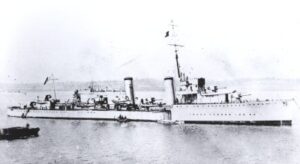 HMS Scotts was the first built by Cammell Laird & Company, Birkenhead, launched 18 October 1917 and completed 1918 at a cost of £342,570, complete. After working up she was assigned to the 10th Destroyer Flotilla, Harwich. Fast forward and in 1918 she escorted a small convoy from the Netherlands to England on 15 August when HMS Ulleswater (M class destroyer) hit a mine or took a torpedo near the Dutch coast. While manoeuvreing to assist her, Scott was hit twice in quick succession, likely by torpedoes as well. The first impact detonated her forward magazine and she sank in 15 minutes with 22 crewmen still on board. Hiostorians today tends to attribute the loss to U-71 which was patrolling and mining the area at the time and was given a double victory either by mines or torpedoes. Her wreck of Scott is still 20 nmi (37 km; 23 mi) off the Dutch coast, cut in two under 20–28 m (66–92 ft) so deep enough not to be a navigation hazard. She is a registered war grave and only ship of her class lost in WWI.
HMS Scotts was the first built by Cammell Laird & Company, Birkenhead, launched 18 October 1917 and completed 1918 at a cost of £342,570, complete. After working up she was assigned to the 10th Destroyer Flotilla, Harwich. Fast forward and in 1918 she escorted a small convoy from the Netherlands to England on 15 August when HMS Ulleswater (M class destroyer) hit a mine or took a torpedo near the Dutch coast. While manoeuvreing to assist her, Scott was hit twice in quick succession, likely by torpedoes as well. The first impact detonated her forward magazine and she sank in 15 minutes with 22 crewmen still on board. Hiostorians today tends to attribute the loss to U-71 which was patrolling and mining the area at the time and was given a double victory either by mines or torpedoes. Her wreck of Scott is still 20 nmi (37 km; 23 mi) off the Dutch coast, cut in two under 20–28 m (66–92 ft) so deep enough not to be a navigation hazard. She is a registered war grave and only ship of her class lost in WWI.
 HMS Bruce (1918)
HMS Bruce (1918)
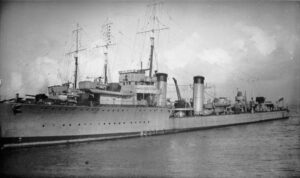 HMS Bruce, named after Robert the Bruce was laid down 12 May 1917, launched 26 February 1918 and completed 30 May 1918. After trials in May 1918 she joining the 10th Destroyer Flotilla in Harwich and on 10 August 1918, she made a sweep against German minesweeping forces in the North Sea with four light cruisers and fourteen destroyers and leaders some towing six CMBs to the edge of the mined areas in the inner German Bight and air cover with both flying boats and Camel fighter carried on towed lighters to deal with Zeppelins. However the lack of wind meant three CMBs without escort were sunk, three more fled to the Netherlands.On Camel shot down the L53.
HMS Bruce, named after Robert the Bruce was laid down 12 May 1917, launched 26 February 1918 and completed 30 May 1918. After trials in May 1918 she joining the 10th Destroyer Flotilla in Harwich and on 10 August 1918, she made a sweep against German minesweeping forces in the North Sea with four light cruisers and fourteen destroyers and leaders some towing six CMBs to the edge of the mined areas in the inner German Bight and air cover with both flying boats and Camel fighter carried on towed lighters to deal with Zeppelins. However the lack of wind meant three CMBs without escort were sunk, three more fled to the Netherlands.On Camel shot down the L53.
On 20-22 November she escorted surrendering U-boats into Harwich. By March 1919 she entered the reserve 7th Destroyer Flotilla in Rosyth. She became Captain (D)’s flagship for the 4th Destroyer Flotilla, Atlantic Fleet until January 1921. On 5 October 1921 she collided with HMS Vendetta. She was in reserve with the 9th Destroyer Flotilla and on October 1922, 8th Destroyer Flotilla, by 3 September 1924, 1st Destroyer Flotilla to replace Wallace and then 8th Flotilla.
In January 1927 she was fully reactivated and sent to the China Station in Hong Kong with the 8th, patrolled off Weihaiwei and other northern ports and worked woth the 4th Submarine Flotilla until January 1937. She assisted the coaster Kwangse, freed from pirates the steamer Helicon, visited Keelung (now in Taiwan) ater a diplomatic incident between Japan and Great Britain and sailed back home via Singapore in early 1937, to Sheerness, placed in reserve at the Nore in April. In September 1937, Portsmouth, not refitted and allocated for sale, stripped but instead assigned as a target and torpedoed to test magnetic detonators on 21 November 1939.
 HMS Douglas (1918)
HMS Douglas (1918)
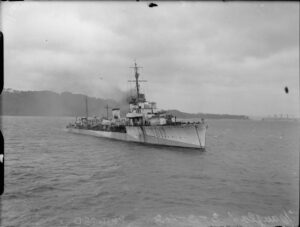 HMS Douglas was laid down on 30 June 1917, launched 8 June 1918 and completed 2 September 1918. Shee operated with the 6th Destroyer Flotilla, Dover Patrol as leader and on 16 September 1918 rescued survivors from the monitor Glatton scuttled in Dover after a magazine fire and explosion. In October she escorted monitors off the Belgian coast, for the raid on Ostend on 17 October 1918, rescuing men from M21 sunk by mines on 20 October. On 25 October she joined the 11th Destroyer Flotilla at Scapa Flow. Postwar on March 1919, she was assigned to the 7th Destroyer Flotilla in reserve at Rosyth. 18 March 1920 saw her in the 4th Destroyer Flotilla, Atlantic Fleet. On 2 December she had a collision at Queenstown, repaired at Pembroke Dock, later reduced to reserve from 26 June 192, laid up at Rosyth and by March 1922 to Devonport, testing cradles for new slipways and back to Devonport. Dhe had a refit in Sheerness January-March 1928 and became leader of the 1st Submarine Flotilla of the Mediterranean Fleet, Malta from 7 April 1928. She had another refit at Sheerness in 1933-1934 (boilers retubed) and back to the 1st Submarine Flotilla, then refitted at Malta in August 1935. She was part of the Abyssinia Crisis with the 1st Destroyer Flotilla From July 1936 she was sent to evacuate British cvilians in Spanish harbours, notably Barcelona. She remained with 1st Destroyer Flotilla until March 1939, refitted at Gibraltar in March-July 1939.
HMS Douglas was laid down on 30 June 1917, launched 8 June 1918 and completed 2 September 1918. Shee operated with the 6th Destroyer Flotilla, Dover Patrol as leader and on 16 September 1918 rescued survivors from the monitor Glatton scuttled in Dover after a magazine fire and explosion. In October she escorted monitors off the Belgian coast, for the raid on Ostend on 17 October 1918, rescuing men from M21 sunk by mines on 20 October. On 25 October she joined the 11th Destroyer Flotilla at Scapa Flow. Postwar on March 1919, she was assigned to the 7th Destroyer Flotilla in reserve at Rosyth. 18 March 1920 saw her in the 4th Destroyer Flotilla, Atlantic Fleet. On 2 December she had a collision at Queenstown, repaired at Pembroke Dock, later reduced to reserve from 26 June 192, laid up at Rosyth and by March 1922 to Devonport, testing cradles for new slipways and back to Devonport. Dhe had a refit in Sheerness January-March 1928 and became leader of the 1st Submarine Flotilla of the Mediterranean Fleet, Malta from 7 April 1928. She had another refit at Sheerness in 1933-1934 (boilers retubed) and back to the 1st Submarine Flotilla, then refitted at Malta in August 1935. She was part of the Abyssinia Crisis with the 1st Destroyer Flotilla From July 1936 she was sent to evacuate British cvilians in Spanish harbours, notably Barcelona. She remained with 1st Destroyer Flotilla until March 1939, refitted at Gibraltar in March-July 1939.
In September 1939, at the start of the Second World War, Douglas was a member of the 13th Destroyer Flotilla, based at Gibraltar, having joined the flotilla on 22 August.[22][25] On 24 October,
Douglas, Keppel, Watchman and Vidette chased for U-37, which sunk three merchant ships, picked up survivors from Tafna. She also towed later a Saro London flying boatwhich recued too much survivors to take-off again. On 21 January 1940 she escorted the convoy OG.15F off Portugal when spotting and attacking U-44, damaged but she fled. On 8 July 1940 she escorted Force H as a diversion during Malta supply missions from Alexandria. She was part of the Battle of Calabria. Bacj home she was refitted and had her condenser repairs replaced. She was reassigned to Scapa Flow for patrols and escorting minelaying operations. On 2 November she rescued 12 survivors from the naval trawler Wardour, hitting a mine on 31 October.
In February 1941, she was assigned to the Western Approaches Command, 2nd Escort Group. On 28 April she joinedd Convoy HX 121, detached from OB 314, rescued 18 survivors from the tanker Capulet (torpedoed by U-552), depth-charged and sank U-65.
On 11 September under W. E. Banks she was detached again from ON 13F to reinforce SC 42 under attack off Greenland (wolfpack Markgraf). She directed Leamington and Veteran to investigate a sighting by an aircraft, later the U-207 was sank. She managed to drive off other attacking U-boats later.
On 15 January 1942 she escorted Convoy ON 55 off Iceland in a severe storm when USS Mayo collided with her. Both were badly damaged. She was repaired at the depot ship Hecla at Iceland. When back home she was converted as a Short-Range Escort in Palmers, Jarrow until April 1942, operational in May. She escorted Convoy PQ 17. In another convoy to the south, she rescued survivors from Louise Moller, sunk by U-172 off Durban. On 11 July 1943 with HMCS Iroquois and frigate Moyola she fought off three Focke-Wulf Fw 200 Condors 300 miles (480 km) off Vigo. She escorted back the badly damaged California and Duchess of York.
On 31 October 1943, she finished off the depht charged(by the trawler Imperialist), the surfaced U-732 west of Gibraltar, rescurting 18 of her crew. She escorted more convoys until February 1945; paid off into reserve, sold for BU 20 March 1945.
 HMS Campbell (1918)
HMS Campbell (1918)
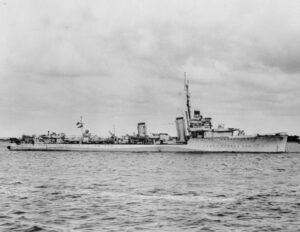 Laid down 10 November 1917, launched 21 September 1918 and completed 21 December 1918. She served with the 15th Destroyer Flotilla, Grand Fleet, as leader until disbanded in April 1919 and then the Atlantic Fleet, 3rd Destroyer Flotilla, Rosyth and later Port Edgar. She led the Third Flotilla to the Baltic Sea aganist Bolshevik Russia. In 1921 she remained with the Third Flotilla and by September 1922 (Chanak Crisis) was sent to Çanakkale on 29 September with her flotilla. In 1923 she joined the 6th Destroyer Flotilla and was hit by a practice torpedo on 8 October 1924, staying 20 days in repairs at Rosyth. By February 1930 she was refitted at Portsmouth, boilers retubed. By June 1931 she was assigned to the 6th Flotilla until May 1935. She took part in the 1935 Silver Jubilee of King George V and joined later the 21st Destroyer Flotilla, Home Fleet, Reserve Fleet during the Abyssinia Crisis, until December 1936. On 21 March 1937 she was sent in Spain and evacuated 450 child refugees from Bilbao to Île d’Oléron, France. By August 1938 she was in reserve on the Nore, refitted by April 1939 until February 1940.
Laid down 10 November 1917, launched 21 September 1918 and completed 21 December 1918. She served with the 15th Destroyer Flotilla, Grand Fleet, as leader until disbanded in April 1919 and then the Atlantic Fleet, 3rd Destroyer Flotilla, Rosyth and later Port Edgar. She led the Third Flotilla to the Baltic Sea aganist Bolshevik Russia. In 1921 she remained with the Third Flotilla and by September 1922 (Chanak Crisis) was sent to Çanakkale on 29 September with her flotilla. In 1923 she joined the 6th Destroyer Flotilla and was hit by a practice torpedo on 8 October 1924, staying 20 days in repairs at Rosyth. By February 1930 she was refitted at Portsmouth, boilers retubed. By June 1931 she was assigned to the 6th Flotilla until May 1935. She took part in the 1935 Silver Jubilee of King George V and joined later the 21st Destroyer Flotilla, Home Fleet, Reserve Fleet during the Abyssinia Crisis, until December 1936. On 21 March 1937 she was sent in Spain and evacuated 450 child refugees from Bilbao to Île d’Oléron, France. By August 1938 she was in reserve on the Nore, refitted by April 1939 until February 1940.
She was assigned to escorts in the North Sea and the Western Approaches and in April 1940, took part in evacuation operations from Harstad and Andfjorden in Norway between 3 and 12 June 1940 and returned to convoy duties. On 20 June 1940 she rescued men from SS Empire Conveyor sank by U-122. On 19/20 November with the Hunt-class Garth off Lowestoft they caught three S-boats, S38, S54 and S57 and she sank S38 y ramming, the rest being driven off, damaged.
On 19/20 November 1941 with HMS Vesper she was in the escort support group for Convoy FS650 (59 merchants) and their close escort when attacked by four S-boats off Great Yarmouth. Campbell mistook Garth for one E-Boote and fire on her seriously damaging her. She towed her back to port.
Campbell joined the Dover Command on 3 February 1942 for an anticipated run of Scharnhorst and Gneisenau, Prinz Eugen from Brest which happened on 11/12 February became never sailed off as they remained undetected. She was in exercise off Harwich when it happened and was sent to intercept them of the River Scheldt, and she joined her at 15:42 hr. Torpedoes were launched from 2,400–4,000 yards (2,200–3,700 m), but nmissed. HMS Worcester was badly damaged in return by gunfire.
On 12 March 1942 she collided with HMS Vesper. She was refitted at Southampton shipyard. On 2-7 September 1942 she escorted the Arctic convoy PQ 18 and more until 1943. She was refitted at London in February-April 1943. On 24/25 October she escorted Convoy FN1160 when attacked by a massive formation of thirty two S-boats. They were driven off but lost the trawler William Stephen. S63 was destroyer by her sister Mackay, S88 by an MGB.
In June 1944, she took part in Operation Neptune (D Day). At sea when the postponement signal was sent out she tried to contact tje the 14th Minesweeper Flotilla about to sweep mines but while closing in was soon surrounded by floating mines, and was painfully extricated by minesweepers.
On 13 May 1945, after many more escorts, she protected the cruiser Devonshire, minelayers Apollo and Ariadne carrying back the Norwegian Government-in-Exile and Crown Prince Olav to Oslo. In reserve, she was transferred on 18 February 1947 for BU at Metal Industries, Rosyth 30 March 1948.
 HMS Malcolm (1919)
HMS Malcolm (1919)
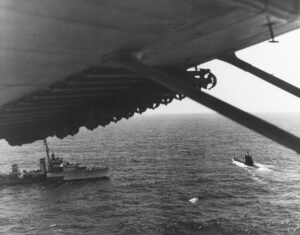
HMS Malcolm was laid down on 27 March 1918, launched on 29 May 1919 and Commissioned on 14 December 1919. She missed WWI and her service in the interwar was unremarkable. In the 1920s, she served with the 5th Destroyer Flotilla, and ended in reserve, still ase flotilla leader, reserve fleet. In September 1939, she became leader of the 16th Destroyer Flotilla at Portsmouth, patrolling the English Channel and Southwest Approaches until May 1940, then Dover Command for the evacuation of troops in the Netherlands.
On 14 May 1940 she transferred Admiral Sir Gerald Charles Dickens and Dutch radar researchers from Scheveningen to HMS Wessex. On 15 May 1940, she took part in Operation Ordnance off the Hook, South Holland. From 26 May to 4 June this was Operation Dyamo, the evacuation of Dunkirk under Sir Thomas Halsey, later DSO on 7 June 1940 “for good services in the withdrawal of the Allied Armies from the beaches at Dunkirk”. Next she was in the anti-invasion patrol with HMS Cardiff. On 14 August 1940 with HMS Verity she fought six Kriegsmarine trawlers and three E-boats. One E-boat, one trawler were sunk.
On 10 September 1940, she attacked invasion barges in Ostend with HMS Wild Swan and HMS Veteran and later shelled Boulogne where more German amphibious vessels were assembled. Next she was redeployed at the Western Approaches Escort Force, Atlantic convoys over 12 months service for 29 Atlantic and 3 Gibraltar convoys. By February 1941 she was in the 8th Escort Group as senior ship under Cdr C D Howard–Johnston as SOE. On 10 May she rescued survivors from Empire Caribou sunk by U-556.
In May 1941 she was sent to reinforce convoy HX 126 under attack, locating and badly damaging U-74. In June she was assigned to HX 133. On 29 June 1941 she co-claimed U-651 and recued 45 of her crew. On 3 February 1942 she collided with HMS Burnham (a former Town class 4 piper). On 11 August 1942 she was sent to Gibraltar, escorting HMS Furious back from Malta. On 12 August she was attacked by the Italian submarine Dagabur, later rammed and destroyed by HMS Wolverine. On 7 September escorted PQ 18 to Arkhangelsk. She arrived on 21 September 1942. In October she was refitted in Liverpool, her bridge and bow receivin armour plates for a difficult mission in Operation Torch.
On 8 November 1942 Malcolm and HMS Broke took part in the Operation Terminal amphibious assault in Algiers. Malcolm tried to break through the boom and was badly damaged by shore batterues, with 10 of her crew killed, more injured, loosin three boilers. She retreated at 4 knots and was withdrawn.
Next she was back to convoy escorts from 22 January 1943, South Atlantic (Freetown-Gibraltar). Between 30 June and 24 August she had an extensive refit. On 4 October she was based in Freetown for local convoy defence. In August 1944 she was back at Gibraltar until 11 June 1945. On 14 June 1945 she was paid off in Plymouth, sold for BU.
 HMS MacKay (1918)
HMS MacKay (1918)
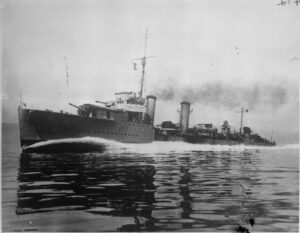 She was Laid down on 5 March 1918, launched on 21 December 1918 and commissioned on June 1919.
She was Laid down on 5 March 1918, launched on 21 December 1918 and commissioned on June 1919.
HMS Mackay was assigned to the 3rd Destroyer Flotilla, Atlantic Fleet in 1919 (Rosyth) and by September was deployed in the Baltic supporting the Estonian forces and shelling the Krasnaya Gorka fort. April-June 1921 saw her off Pembroke Dock after the industrial unrest in South Wales. She was refitted at Chatham July-August and took later the lead of the 4th Destroyer Flotilla and deployed to the Dardanelles, sailing on 23 February and operating until August 1923, then under refit at Chatham. By December she was in the 9th Destroyer Flotilla, Rosyth, reduced crews until November 1925 and by 1927 recommissioned with the 5th Destroyer Flotilla, refitted by November 1927 at Sheerness until April 1928, then reserve until June 1929, 1st Destroyer Flotilla Mediterranean. She was not sold in 1933 to Australia, Stuart being transferred instead. She served with the 2nd Submarine Flotilla, Devonport in April and on 8 October assisted the submarine L26 after a battery explosion in Campbeltown harbour. Next she served with the 2nd Submarine Flotilla until September 1935, and with the Abyssinia Crisis, from Malta. By March 1936 she was in reserve at Devonport. On 25 July 1938 she took the lead of the 2nd Submarine Flotilla and briefly with the 12th Destroyer Flotilla and back untul August 1939.
She was assigned to the 11th Destroyer Flotilla, Western Approaches Command, Devonport and Liverpool. On 15 September she drive off and gunned U-53 after she torpedoed the tanker Cheyenne. On 9 December 1939, she escorted Convoy OB 48 scuttled the wreck of the torpedoed tanker San Alberto (U-48), rescued her crew. On 17 January 1940 she escorted Convoy OB 74, and rescued the crew of the merchant Cairnross off Liverpool.
On 26 May 1940, she took part in Operation Dynamo, saving 581 troops on 28 May, but when back on 28/29 May, ran aground off Zuydcoote. Refloated, she was repaired at Sheernes on 3-5 June. Next in the English Channel she took part in Operation Aerial other evacuations and from Brest on 16–17 June, La Pallice on 20 June then Saint-Jean-de-Luz on 24 June.
She was with the 11th Flotilla until October 1940 and after refit at Devonport (boilers replaced) she was assigned to the joined the 16th Destroyer Flotilla in Harwich. On 12 February 1942 she ws sent to German battleships during their Channel dash. Mackay launched her torpedoes from 4000 yards but missed.
On 29 August 1942, she was detached to the Home Fleet, supporting the Arctic convoy PQ 18 to Northern Russia and return QP 14 and worked as distant cover force with HMS Anson and Duke of York until back home on 27 September 1942.
On 21 December she did the same until the 26th. On 7/8 March 1943 she repelled an E-Boat attack with MGB 20, MGB 17 and MGB 21 in the Thames estuary. On 24/25 October 1943 she fended off an atack from 32 German E-boats on Convoy FN 1160 off Cromer. Mackay rammed and sank S63. On 5/6 January 1944 while escorting convoy WP 457 she repelled seven German E-boats in bad weather. On 7 June 1944, she escorted convoys to the beaches for Operation Neptune. She went on escorting convoys until V-Day in Europe. On 8 May 1945 she took part in the Liberation of Norway. She was solf for BU on 18 February 1947, scrapped until 1949.
 HMS Stuart (1918)
HMS Stuart (1918)
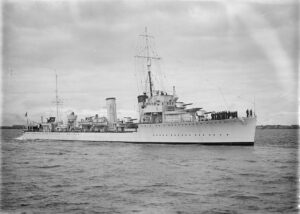 HMS Stuart was laid down on 18 October 1917, launched on 22 August 1918 and commissioned on 21 December 1918. She missed the war and was assigned afterwards to the Mediterranean 2nd Destroyer Flotilla, between Gibraltar and Malta. In 1919–20 she was in the Black Sea, supporting hite Russians at Yalta in April 1919 and evacuating troops from the British military mission in March 1920 close to Novorossiysk. She assisted the Greeks against the Turks in the Aegean Squadron, escorting troopships when landing on Smyrna in May 1919 and Panderma in July 1920. In early 1921 she was sent to Constantinople at the end of the war.
HMS Stuart was laid down on 18 October 1917, launched on 22 August 1918 and commissioned on 21 December 1918. She missed the war and was assigned afterwards to the Mediterranean 2nd Destroyer Flotilla, between Gibraltar and Malta. In 1919–20 she was in the Black Sea, supporting hite Russians at Yalta in April 1919 and evacuating troops from the British military mission in March 1920 close to Novorossiysk. She assisted the Greeks against the Turks in the Aegean Squadron, escorting troopships when landing on Smyrna in May 1919 and Panderma in July 1920. In early 1921 she was sent to Constantinople at the end of the war.
Post 1923 to 1933 she had routine assignments. She was decom. in May 1933 with four V and W-class destroyers, then transferred to the RAN, replacing the older HMAS Anzac. She ws in Sydney on 21 December.
She was decommissioned into reserve on 1 June 1938, briefly reactivated from 29 September to 30 November 1938, recommissioned on 1 September 1939 under Hector Waller and on 14 October, she led the RAN destroyer flotilla from Sydney to Malta. New the 19th Destroyer Division or infamous “Scrap Iron Flotilla”, it was merged with the 20th Division creating the more potent 10th Destroyer Flotilla. In July 1940 she was at the Battle of Calabria. She provided gunfire during the Western Desert Campaign. On 30 September 1940 she attacked the Italian submarine Gondar which crew surrendered. She supported the 6th Australian Division off Tobruk on 22 January 1941 and was at the Battle of Cape Matapan in March 1941, hitting the Italian cruiser Zara with a torpedo.
She assisted in the evacuation from Greece in April 1941 and from Crete in May 1941. In June-July 1941 she supplied Tobruk besieged, making 24 runs. Problems with her port engine had her sent back to Sydney for repairs, until April 1942. Next she served as local convoy escort, eastern Australian waters. By late 1943 until early 1944 she was was converted as a depot/troop transport (APD) and took part in the New Guinea campaign until the end of WW2, earning eight eight battle honours for her service. Decom. stricken on 27 April 1946 she was sold for BU on 3 February 1947.
 HMS Montrose (1918)
HMS Montrose (1918)
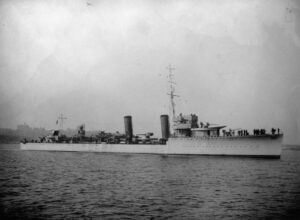 First to be built at Hawthorne Leslie, she was laid down on 27 March 1918, launched on 29 May 1919 and commissioned on 14 December 1919. She served with the 10th Destroyer Flotilla, Harwich Force in place of HMS Scott sunk on 15 August. On 1 October 1918 she patrolled off the Schouwen Bank, patrolling to intercept any German shups heading for Germany. From February 1919 she joined the Mediterranean Fleet with the 6th Destroyer Flotilla, for ten years. She took part in the Russian Civil War evacuation from Sevastopol to Novorossiysk by April 1919. In May–June 1919 she operated off Feodosia and Arabat Spit, Kerch Peninsula. In December 1919 her captaon won a DSO for this campaign. In March 1920 she evacuated remnants of the White Army at Novorossiysk and later took off refugees from Yalta.
First to be built at Hawthorne Leslie, she was laid down on 27 March 1918, launched on 29 May 1919 and commissioned on 14 December 1919. She served with the 10th Destroyer Flotilla, Harwich Force in place of HMS Scott sunk on 15 August. On 1 October 1918 she patrolled off the Schouwen Bank, patrolling to intercept any German shups heading for Germany. From February 1919 she joined the Mediterranean Fleet with the 6th Destroyer Flotilla, for ten years. She took part in the Russian Civil War evacuation from Sevastopol to Novorossiysk by April 1919. In May–June 1919 she operated off Feodosia and Arabat Spit, Kerch Peninsula. In December 1919 her captaon won a DSO for this campaign. In March 1920 she evacuated remnants of the White Army at Novorossiysk and later took off refugees from Yalta.
By September 1922 she was sent on Çanakkale during the Chanak Crisis. In May 1923 she sailed with HMS Iron Duke, cruiser Centaur and five destroyers from Malta to the Dardanelles during the war between Greece and Turkey. October 1923 saw her with the 4th Destroyer Flotilla at Malta. February 1925 saw her with the 5th Destroyer Flotilla, then 1st Destroyer Flotilla from January 1927. On 20 June 1927 she escorted Renown when leaving Malta with the Duke and Duchess of York after their tour.
She was refitted at Devonport in May-November 1929, boilers retubed, placed in reserve at Sheerness until 4 December 1930, versed to the 6th Destroyer Flotilla, Atlantic Fleet and 1931 again in reserve at Portsmouth. In November she joined the 5th Destroyer Flotilla, then reserve at Devonport, June 1932. 10 July 1935 saw her operating in the English Channel unattached until September, joining the 20th Destroyer Flotilla. She had a refit at Devonport from 22 November 1935 to 13 January 1936, attended the funeral of King George V in January 1936 and was back in reserve at Devonport from May 1936.
By September 1939 she led the 17th Destroyer Flotilla from Milford Haven, Western Approaches Command and tasked of anti-submarine patrols, convoy escort, East Atlantic. On 30 September 1939, she spotted and attacked a contact south of Plymouth. On 2 October 1939 with HMS Keith she did the same on another, no kill.
On 26 May 1940 she took part in Operation Dynamo and on 28 May evacuated 925 troops but on 29 May collided in a fog the tug Sun V, later repairs at Harland and Wolff until 5 July 1940. Next she led the 18th Destroyer Flotilla, Nore Command (Harwich) and by July 1940 tried to AA gun passing by German aircraft carried. On 27 July with HMS Wren while escorting minesweepers off Aldeburgh in Suffolk she was attacked, claimed two German bombers but had near-miss which badly damaged her and Wren sank. She was towed back to Sheerness for repairs.
MShe left on October 1941 for the 16th Destroyer Flotilla, Scapa Flow until November 1941 and by December she was part of the covering force, Operations Anklet and Archery, the raids on Lofoten and Vågsøy, northern Norway. On 30 December she hit an uncharted rock off Herston, Orkney, repaired at Rosyth until May 1942.
On 1 August 1942 she was sent to the Mediterranean to take part in Operation Pedestal, the largest Malta Convoy
Next she escorted the Arctic convoys PQ 18 and QP 14 in September 1942. In December 1942 to January 1943 she did the same with RA 51 and JW 52. On 1 February 1943 she resumed coastal patrols, east coast and on 17/18 February 1943, with Garth on patrol she met R-boats protected by E-Boats that laying a minefield off Lowestoft. S71 was rammed and sunk by Garth. On 24 October 1943 she collided with HMS Cotswold, and was repaired. 5 June 1944 she left Harwich to escort vessels to the Eastern operating area, and was awarded her last battle honour. On 7 July she collided with Empire Heywood off Harwich. On 19 July she collided with LST-430, repaired in Immingham but this was cut short, she was decommissioned, placed into the Category C Reserve on 2 November 1944, sold for BU in 31 January 1946.
Read More/Src
Books
Cocker, Maurice Destroyers of the Royal Navy, 1893-1981, 1983, Ian Allan
Conway’s All the World’s Fighting Ships, 1922-1946, Ed. Robert Gardiner, Naval Institute Press
M. J. Whitley Destroyers of World War II, An International Encyclopedia, Arms and Armour Press, 1988
Links
http://www.navypedia.org/ships/uk/brit_dd_scott.htm
https://en.wikipedia.org/wiki/Admiralty_type_flotilla_leader
http://www.navweaps.com/Weapons/WAMBR_ASW.php
Model Kits
None found

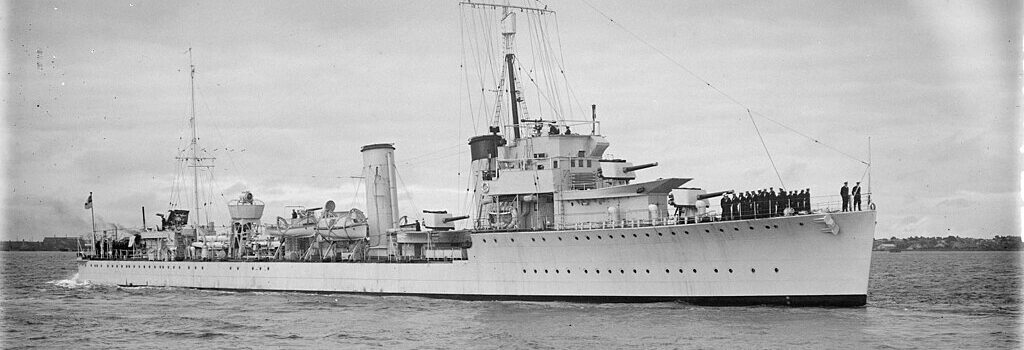
 Latest Facebook Entry -
Latest Facebook Entry -  X(Tweeter) Naval Encyclopedia's deck archive
X(Tweeter) Naval Encyclopedia's deck archive Instagram (@navalencyc)
Instagram (@navalencyc)





 French Navy
French Navy Royal Navy
Royal Navy Russian Navy
Russian Navy Armada Espanola
Armada Espanola Austrian Navy
Austrian Navy K.u.K. Kriegsmarine
K.u.K. Kriegsmarine Dansk Marine
Dansk Marine Nautiko Hellenon
Nautiko Hellenon Koninklije Marine 1870
Koninklije Marine 1870 Marinha do Brasil
Marinha do Brasil Osmanlı Donanması
Osmanlı Donanması Marina Do Peru
Marina Do Peru Marinha do Portugal
Marinha do Portugal Regia Marina 1870
Regia Marina 1870 Nihhon Kaigun 1870
Nihhon Kaigun 1870 Preußische Marine 1870
Preußische Marine 1870 Russkiy Flot 1870
Russkiy Flot 1870 Svenska marinen
Svenska marinen Søværnet
Søværnet Union Navy
Union Navy Confederate Navy
Confederate Navy Armada de Argentina
Armada de Argentina Imperial Chinese Navy
Imperial Chinese Navy Marinha do Portugal
Marinha do Portugal Mexico
Mexico Kaiserliche Marine
Kaiserliche Marine 1898 US Navy
1898 US Navy Sovietskiy Flot
Sovietskiy Flot Royal Canadian Navy
Royal Canadian Navy Royal Australian Navy
Royal Australian Navy RNZN Fleet
RNZN Fleet Chinese Navy 1937
Chinese Navy 1937 Kriegsmarine
Kriegsmarine Chilean Navy
Chilean Navy Danish Navy
Danish Navy Finnish Navy
Finnish Navy Hellenic Navy
Hellenic Navy Polish Navy
Polish Navy Romanian Navy
Romanian Navy Turkish Navy
Turkish Navy Royal Yugoslav Navy
Royal Yugoslav Navy Royal Thai Navy
Royal Thai Navy Minor Navies
Minor Navies Albania
Albania Austria
Austria Belgium
Belgium Columbia
Columbia Costa Rica
Costa Rica Cuba
Cuba Czechoslovakia
Czechoslovakia Dominican Republic
Dominican Republic Haiti
Haiti Hungary
Hungary Honduras
Honduras Estonia
Estonia Iceland
Iceland Eire
Eire Equador
Equador Iran
Iran Iraq
Iraq Latvia
Latvia Liberia
Liberia Lithuania
Lithuania Mandchukuo
Mandchukuo Morocco
Morocco Nicaragua
Nicaragua Persia
Persia San Salvador
San Salvador Sarawak
Sarawak Uruguay
Uruguay Venezuela
Venezuela Zanzibar
Zanzibar Warsaw Pact Navies
Warsaw Pact Navies Bulgaria
Bulgaria Hungary
Hungary

 Bundesmarine
Bundesmarine Dutch Navy
Dutch Navy Hellenic Navy
Hellenic Navy Marina Militare
Marina Militare Yugoslav Navy
Yugoslav Navy Chinese Navy
Chinese Navy Indian Navy
Indian Navy Indonesian Navy
Indonesian Navy JMSDF
JMSDF North Korean Navy
North Korean Navy Pakistani Navy
Pakistani Navy Philippines Navy
Philippines Navy ROKN
ROKN Rep. of Singapore Navy
Rep. of Singapore Navy Taiwanese Navy
Taiwanese Navy IDF Navy
IDF Navy Saudi Navy
Saudi Navy Royal New Zealand Navy
Royal New Zealand Navy Egyptian Navy
Egyptian Navy South African Navy
South African Navy






























 Ukrainian Navy
Ukrainian Navy dbodesign
dbodesign